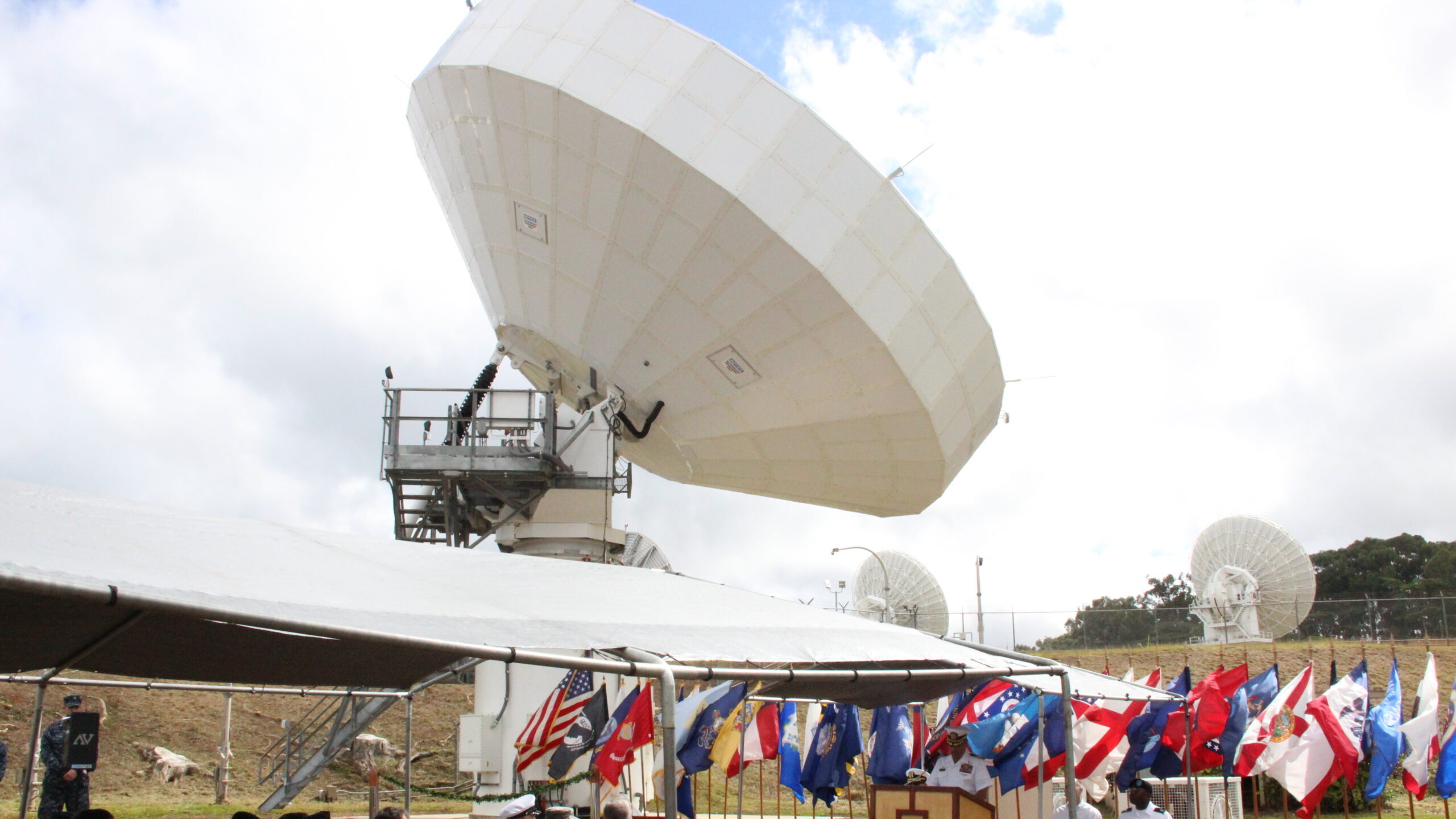
Capt. William A. Dodge Jr., commander, Naval Computer and Telecommunications Area Master Station, Pacific, speaks during the commissioning of the first operational AN/GSC-52B(V5) Modernized Enterprise Terminal (MET) April 16 at the Wahiawa Satellite Communications (SATCOM) Facility Hawaii.(U.S. Navy photo by Ensign Denise Baumeister/Released)
WASHINGTON — Modernizing the Pentagon’s satellite communications (SATCOM) capabilities into a “resilient enterprise” will take a phased approach led by several of the Pentagon’s agencies and commands, according to a new plan released by the Defense Department’s chief information office.
The Enterprise Satellite Communications Management and Control (ESC-MC) Implementation Plan, published Wednesday, “provides the foundational capabilities necessary for the on-going Future SATCOM Force Design, including increased reliance on commercial SATCOM and stronger partnerships with our allies, as the Department builds out and executes Joint All Domain Command and Control (JADC2).”
“This Implementation Plan establishes the foundation for establishing ESC-MC for the DoD SATCOM community and fielding those capabilities in a phased manner to begin the incremental improvement of the management of SATCOM at the soonest practicable time,” the document asserts.
According to the plan, Space Command will act as the global SATCOM operations manager and operator of the EMC-MC capability, the Space Force as the force design architect, the DoD CIO as the lead architect for the capability and the Defense Information Systems Agency as a DoD enterprise service provider and DoD Information Network representative.
The Space Force’s Space Warfighting Analysis Center (SWAC) has been working on a force design concept for SATCOM that can provide a foundational layer for JADC2, with an eye on the fiscal 2024 budget process. The effort is complex. Two key questions are about the composition of the on-orbit architecture and how quickly user terminals (i.e. radios) used by soldiers, sailors, airmen and Marines can be either upgraded or replaced — and if the latter, whether that is cost prohibitive in the near term.
Col. Edward Ferguson, deputy director of space and missile defense at DoD’s Acquisition and Sustainment office, told the GovConWire 2023 Acquisition Forum that the SWAC effort is still ongoing.
“We’re looking at SATCOM not … the way we’ve done it before — in narrowband and wideband and tactical — but we’re looking at satellite communications as a holistic capability,” he said Wednesday.
The detailed planning document builds off of the DoD’s Digital Modernization Strategy, in particular that effort’s focus on modernizing command, control, communications and computer systems and infrastructure.
It also is designed to substantiate the Chief of Space Operations’ Vision for Satellite Communications, first reported by Breaking Defense back in 2019, which called for the creation of a seamless network of military and commercial comsats in all orbits, accessible to troops, vehicles, ships and aircraft via ground terminals and mobile receivers that would automatically “hop” from one satellite network to another to avoid jamming.
The plan includes three phases of implementation, starting this fiscal year with establishing ESC-MC governance and standards. In particular, standards are necessary to allow DoD’s multiple SATCCOM networks and their myriad terminals to interface with each other, as well as open system data standards that can feed into a JADC2 network of networks — the latter being something that the Joint Staff has been working on for some time.
It is also broken down into three imperatives: integrating data management, automating resource allocation and fusing situational awareness.
One of the problems faced today by commanders seeking access to SATCOM bandwidth is that there are a number of different network request processes. The implementation plan stresses that in order for SATCOM allocation to meet tactical timelines as described in the CSO’s Vision, “all separate satellite and enterprise SATCOM network access request processes must be integrated into a single process.”
“Implementing enterprise SATCOM M&C will enable DoD SATCOM modernization through its development of and access to core enterprise capabilities; these capabilities will increase the flexibility, agility and resiliency of DoD SATCOM, while leveraging the full use of a hybrid, heterogeneous enterprise that issues the best mix of commercial and military solutions,” according to the plan.
The implementation plan lists seven “core capabilities” that need to be achieved: mobility and continuous communications; ESC Management Common Operating Environment; Enterprise SATCOM Situational Awareness/Common Operational Picture; automated resource allocation; electro-magnetic interference mitigation; continuity of operations; and element/enterprise network interface.
Those capabilities, and the execution of the ESC-MC plan, will be tracked by DoD CIO’s SATCOM System Engineering Group, which will report up to the C3 Leadership Board. According to the plan, the approach used by the two groups “advocates for centralized situational awareness at the top ‘enterprise’ level and decentralized execution at the ‘element’ level.”
The C3 Leadership Board is also tasked with establishing an ESC-MC Technical Working Group to track the plan of action and milestones set forth in the strategy.






















